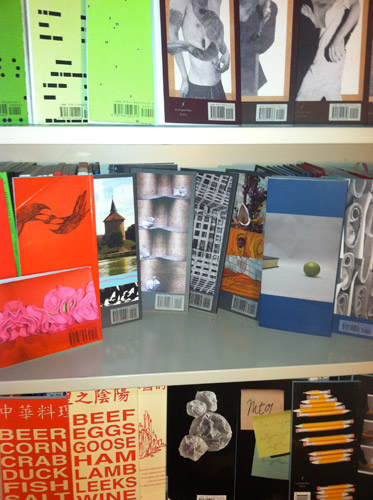 Every writer is in conversation with other writers, a text in conversation with other texts. TrenchArt is an annual book series that explores this notion by presenting new works of literature as part of a larger cultural and aesthetic conversation. Each series features a set of five books that, when placed in proximity, resonate in their conceptual / formal concerns.
Every writer is in conversation with other writers, a text in conversation with other texts. TrenchArt is an annual book series that explores this notion by presenting new works of literature as part of a larger cultural and aesthetic conversation. Each series features a set of five books that, when placed in proximity, resonate in their conceptual / formal concerns.
In curating each TrenchArt series, we are more concerned with textual affinities than set notions of genre. Since 2005, TrenchArt titles have included poetry, short stories, novels, non-fiction, drama, visual art, translation, and the unclassifiable. The series brings together a vast range of artists and writers from as varied locations as the United States, Mexico, Germany, Brazil, and the United Kingdom. With their unusual trim-size (4.25″ x 9.25″) and visual continuity (each series has a distinct base color), each TrenchArt series is a group exhibition; the site is the book. The back cover of each book showcases visual art made in response to the text within.
For each of the series, Les Figues edits and publishes a book of aesthetic statements written by participating series writers and artists. In writing this piece, we encourage the writers and artists to reflect on their individual process and the big questions in their work: why do they make what they make, why make at all? These aesthetic collections are hand-bound in limited-editions, giving readers access to the (or some of the) thinking behind the works.
Note: TrenchArt takes its name from the better known trench art—artistic creations produced by soldiers in wartime, made of whatever material was on hand, often shell casings and scrap metal. It is the art born of conflict and community: here we are, together in the trenches. It is also an art varied in style and form but unified in context.
The TrenchArt Series of New Literature
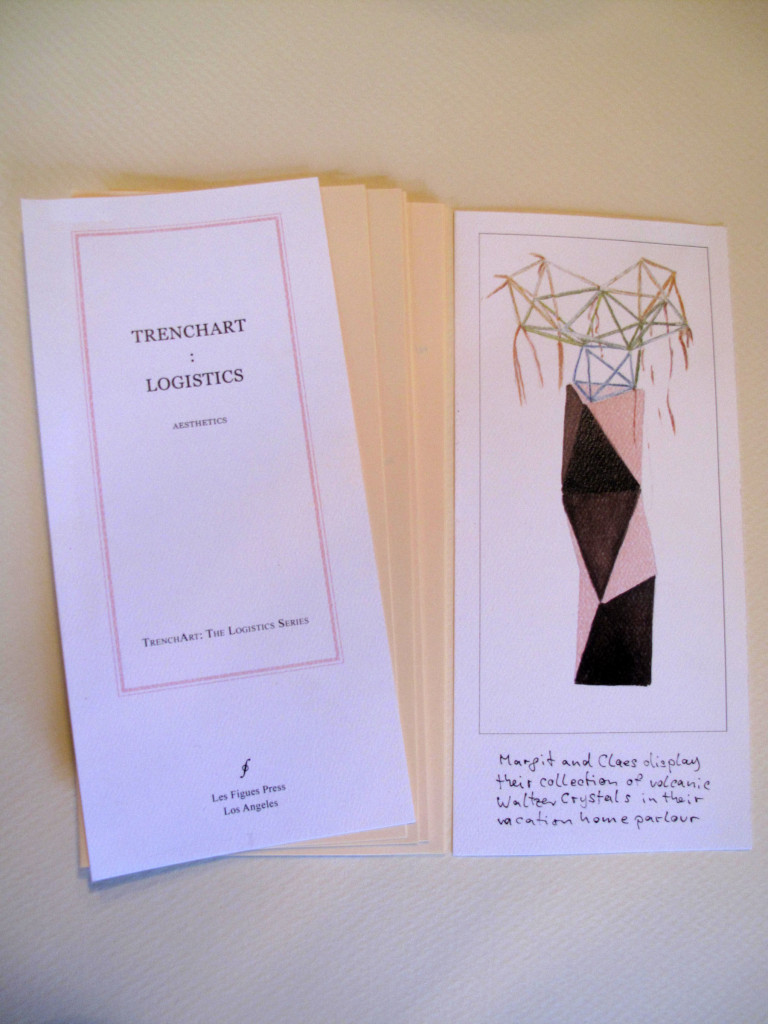 |
TRENCHART: LOGISTICS 2013. Each of the books in the TrenchArt: Logistics series uses the cut, and cutting, as an organizing principal. In Our Lady of the Flowers, Echoic, Chris Tysh translates Notre-Dame-des-Fleurs, compressing Jean Genet’s disturbing 1943 novel into cuttingly charged verse. In Cunt Norton, Dodie Bellamy “cunts” The Norton Anthology of Poetry (1975 edition), setting her text-ravenous cut-ups loose to devour the canonical voices of English literature. In Things to Do With Your Mouth, Divya Victor repeats, recants, and endlessly says again what has already been said, affirming her right to her “buccal” opening, words, and discourse. And in Film Poems, Redell Olsen explores image-text relations so that words become, as she says, “the film between what was said and seen and also the means of seeing that is something burning in the projector called language.” Each book is accompanied by visual art by Alice Könitz. |
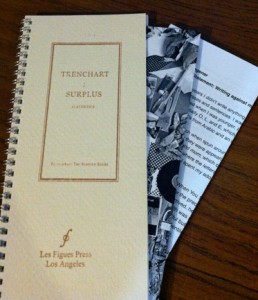 |
TRENCHART: SURPLUS 2012. The books in the TrenchArt: Surplus series are uniformly excessive. In 2500 Random Things About Me Too, Matias Viegener turns a Facebook meme into a 242-page list contemplating much more than the random; in Lividity, Kim Rosenfield uses language drained of meaning—excess words—to make micro-conversations nonetheless. Michael du Plessis collages countless texts into the seamless narrative in The Memoirs of JonBenet by Kathy Acker, and Mark Rutkoski hand-lists each of the words in Shakespeare’s 154 sonnets in Words of Love. In For Want and Sound, Melissa Buzzeo writes a philosphical lyric exploring boundarylessness. The Surplus Series includes an extra book—six instead of the usual five; Klaus Killisch is the series visual artist. |
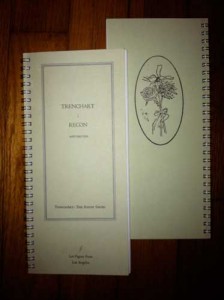 |
TRENCHART: RECON 2011. “Recon” for reconnaissance, recognition, a preliminary survey to gain information, an exploratory military survey of enemy territory. The writers in the TrenchArt: Recon series experiment with the material of language to explore new possibilities for such literary stand-bys as lyric, plot, or portrait. Myriam Moscona‘s Negro marfil/Ivory Black, translated by Jen Hofer, is a book-length experiment in inversions, while Doug Nufer’s By Kelman Out of Pessoa is a literal experiment at the racetrack. Alex Forman appropriates facts and rumors to create portraits of the first 37 U.S. Presidents in Tall, Slim & Erect: Portraits of the Presidents, while Frances Richard considers particles of matter and sound in The Phonemes. Visual artist Renée Petropoulos uses the series as a site to create representations of the individual texts and national systems of identity. |
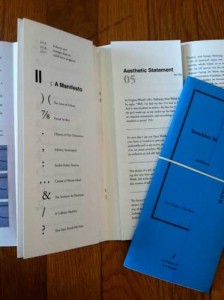 |
TRENCHART: MANEUVERS 2010. TrenchArt: Maneuvers explores the possibilities of re-ordered time and content framed with the understanding that content cannot be separated from time, and that to shift the order will shift the form, thus shifting the subjectivies of a text. In Sonnet 56, Paul Hoover presents 56 formal variations of Shakespeare’s “Sonnet 56,” while Harold Abramowitz’s narrator repeatedly returns to the same shifting memory in Not Blessed. In The Evolutionary Revolution, Lily Hoang writes a fabulist tale of contradictory harmonies, and Mathew Timmons re-writes the ever-elusive “new” in The New Poetics. Maneuvers series visual art by VD Collective. |
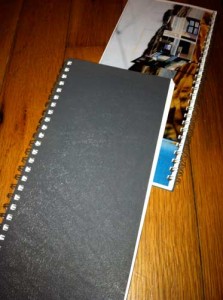 |
TRENCHART: TRACER 2008/09. COMPLETE SET SOLD OUT A tracer is ammunition containing a chemical substance that leaves a trail of smoke or fire, illuminating the target for others. The books in the TrenchArt: Tracer series expose boundaries of genre—poetry is traced with prose, prose with poetry. Kim Rosenfield’s re:evolution is poetry-as-guidebook-for-living-and-evolution, while Allison Carter’s A Fixed, Formal Arrangement uses the short prose form to render the liminal space of between-ness. Amina Cain’s short stories in I Go To Some Hollow explore what’s left unsaid and unseen between humans and their environments, while in a, Sophie Robinson documents the detritus of sudden loss, layering word and image, object and subject, the said with the unsayable. These tracers fire from the borders or gaps in the old original, making new literary spaces. Tracer series visual art by Susan Simpson and Ken Ehrlich. |
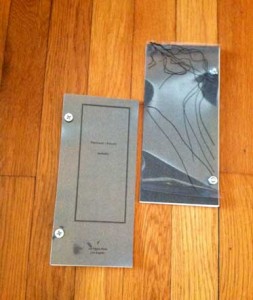 |
TRENCHART: PARAPET 2007/08. In “Cups & Mutts, an Introduction” to TrenchArt: Parapet, Vanessa Place writes: “The pieces in this series resemble themselves and their opposites, which are sometimes one another, and sometimes themselves again. The self-negation that circles around Alta Ifland (Voice of Ice) and Stan Apps (God’s Livestock Policy) finds its counterweight in the god-act of creation celebrated by Danielle Adair (visual art) and Stephanie Taylor (Chop Shop), and the shadowed part of this Venn diagram is joyously occupied by Axel Thormählen (A Happy Man and Other Stories), who is his own Adam, tasting of the apple and pronouncing it picaresque. [ . . . ] We cannot help our walls. They give us something to raise and raze, to scale over and stand beside, one side or the other, it doesn’t really matter. The point is the parapet and the brazen trumpet of our own sweet making.” |
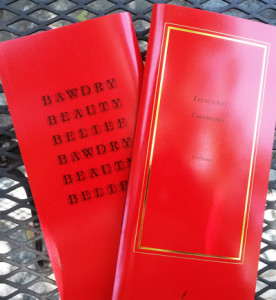 |
TRENCHART: CASEMENTS 2006/07. What is a window, but a frame arbitrarily placed in a space of unlimited possibility. The writers in the TrenchArt: Casements series survey the fields of language and form and set a constraint—a window—to contain and order the chaos. Christine Wertheim presents part of an ongoing poetic inquiry into the structures of language, discovering fresh systems of meaning in a specific set of English graphemes (+|’me’S-pace). Vincent Dachy’s frame is the slide, set in a show, imaging the psychic pathos of Western culture (Tribulations of a Westerner in the Western World). The two plays by Sissy Boyd maintain their spare posture despite time’s entropy; systems fail even as form holds (in the plain turn of the body make a sentence). Nuala Archer’s haiku breaks through the window and across the form’s frame to turn and look back at the view from the other side (Inch Aeons). |
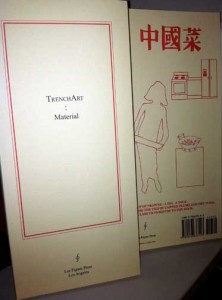 |
TRENCHART: MATERIAL 2005/06. COMPLETE SET SOLD OUT Each of the titles in the TrenchArt : Material series backstitches canonical Western literature into a contemporary American text. These books integrate traditional literary forms—the war story, the nature poem, the folk story, the fairy tale—into new work that resurrects human relevance while pushing their chosen containers even further. From Vanessa Place’s war story rifled into a tense-filled, single sentence (Dies: A Sentence), to Pam Ore’s nature poems pacing within human-built zoos and human-adapted language (Grammar Of The Cage); from Teresa Carmody’s stories of Biblical folk in the middle-spread of America (Requiem) to Jennifer Calkins’ fairy-tale forest of modern medicine (A Story of Witchery), history becomes presently important, and the literary (and ecumenical) canon fodder for cultural retooling and retelling. |
Comments are closed.